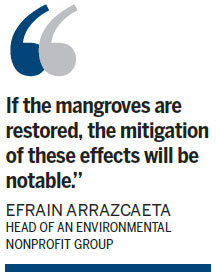Cuba looks to replenish mangroves
Many people in this tiny hamlet on the southern coast of Cuba remember when the shore lay about 100 meters farther out. That was four decades ago.
Since then, rising waters have gradually swallowed up rustic homes, a narrow high-way that once paralleled the coast, even an old military tank that people now use to measure the sea's yearly advance.
"There was a road there," said Jose Manuel Herrera, 42, a fisherman and former charcoal harvester, pointing toward the gentle waves. "You could travel from here all the way to Mayabeque."
Worried by forecasts of rising seas from climate change, the effects of hurricanes and the salinization of farmlands, authorities say they are beginning a forced march to repair Cuba's first line of defense against the advancing waters - its mangrove thickets, which have been damaged by decades of neglect and uncontrolled logging.
In the second half of 2013, a moratorium was declared on mangrove logging. Now, the final touches are being put to a sustainable management master plan that is expected to be in place before the end of the year. President Raul Castro has said the plan is a top priority.

What makes the effort vital and closely monitored by environmentalists is that Cuba is one of the few places left in the Caribbean with extensive mangrove forests. Cuba accounts for about 69 percent of the region's current mangroves, the New York-based Environmental Defense Fund says. Mangroves act as both a barrier to the sea and a saltwater filter, making them important for coastal health.
Mangroves historically have been harvested heavily, for textile dyes, tannins used in the pharmaceutical industry, lumber for furniture and charcoal that rural Cubans rely on to fire their kitchens.
But healthy mangrove stands are important in alleviating one of the island's biggest headaches. Rising seas stand to wipe 122 towns off the map and penetrate up to 2 km inland in low-lying areas by 2100, posing a serious threat to coastal communities and agriculture, according to a government study last year.
Efrain Arrazcaeta, who runs an environmental nonprofit group, has witnessed the phenomenon with growing alarm. His group estimates a 2-meter maritime advance each year, using the submerged tank as a reference point.
"If the mangroves are restored, the mitigation of these effects will be notable," Arrazcaeta said.
Extensive reforestation isn't easy. There's no way of mechanizing the process, which means brigades of workers will have to wade into the swampy terrain and plant each mangrove by hand.
Financing for the plan comes from various ministries as well as a UN program on climate change adaptation. Officials declined to give budget figures, but said it's in the millions of dollars.
(China Daily 07/25/2014 page10)














